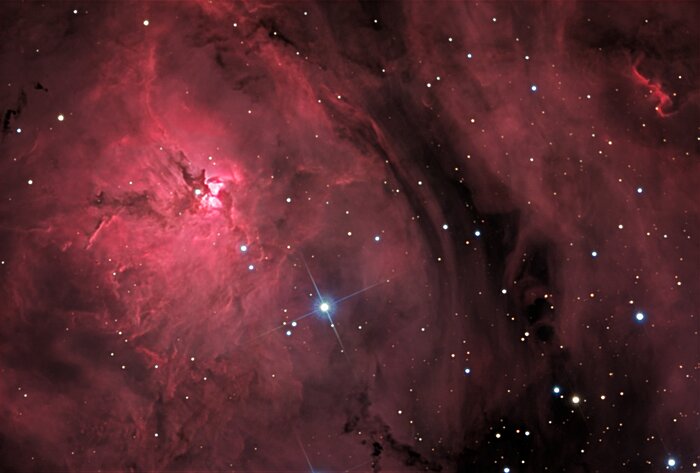M8: Lagoon Nebula
M8, the Lagoon Nebula, is a tremendous star forming region in our galaxy. Under dark skies it is easily seen with the unaided eye just above the "teapot" (spout) asterism of Sagittarius. A view through a small telescope (with the eye) shows the milky glow of nebulosity pervades the entire field. A star cluster, NGC 6530, highlights how star formation is proceeding in this cloud. A few of NGC 6530's stars can been seen in the bottom right of this image, but most of it is just outside the field to the right.CCD images like this hint at the turbulent activity of the gases in the cloud. As stars form, they create strong stellar winds (and radiation) that heat and churn their surrounding natal material. Shown here is a particularly dense part of M8 with an "hour-glass" like shape. This hour-glass is the brightest part of the nebula left of the dark rift (Lagoon?) that divides the nebula. The star next to the hourglass is called Herschel 36 and it is most responsible for all of the activity in this area. The hour-glass structure itself spans a little more than a lightyear across in the longest dimension. At this scale, our solar system would be about 1/1000th of a pixel.
This image was taken as part of Advanced Observing Program (AOP) program at Kitt Peak Visitor Center during 2014.
Créditos:KPNO/NOIRLab/NSF/AURA/Jack Harvey and Tom Doughtery/Adam Block
About the Image
| Id: | noao-m8harvey |
| Tipo: | Observation |
| Release date: | 7 de Junio de 2014 a las 13:45 |
| Size: | 1492 x 1009 px |
Sobre el Objeto
Fondos de Pantalla
Coordenadas
| Posición (AR): | 18 3 52.43 |
| Posición (Dec): | -24° 22' 56.96" |
| Campo visual: | 12.10 x 8.19 arcminutes |
| Orientación: | North is 201.3° right of vertical |
Colores y Filtros
| Banda | Longitud de Onda | Telescopio |
|---|---|---|
| Optical B | 438 nm | Visitor Center 0.5-meter Telescope Other CCD |
| Optical G | 475 nm | Visitor Center 0.5-meter Telescope Other CCD |
| Optical R | 625 nm | Visitor Center 0.5-meter Telescope Other CCD |
| Optical Broad Band | 555 nm | Visitor Center 0.5-meter Telescope Other CCD |

